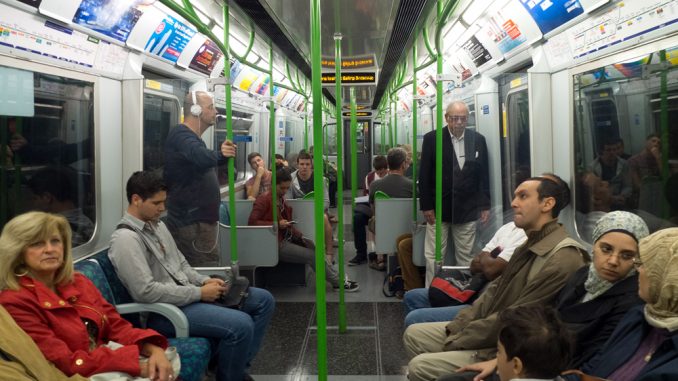
 Perhaps to a SEPTA rider, it would seem strange to have well-maintained, fabric seats in the subway trains, given the amount of liquids and organic particles that find their way in. But riders of the London Underground, or “Tube” as it’s colloquially known, appear to have great self-control. As a regular user of the Broad Street and Market-Frankford subway lines, the Piccadilly and Central lines are a welcomed vacation.
Perhaps to a SEPTA rider, it would seem strange to have well-maintained, fabric seats in the subway trains, given the amount of liquids and organic particles that find their way in. But riders of the London Underground, or “Tube” as it’s colloquially known, appear to have great self-control. As a regular user of the Broad Street and Market-Frankford subway lines, the Piccadilly and Central lines are a welcomed vacation.
Trains, or stock, are either tube stock or rolling stock, depending on the line. Either way, I can take one of the aforementioned seats that line the sides of the “carriage,” or take a pole. Being 5 feet 4 inches, I fit nicely inside Tube carriages. But it’s the width that strikes you first. Stock carriages, which are replacing the older models, measure about 9 feet 6 inches across, and about 9 feet 5 inches tall. It sounds reasonable, until you consider that SEPTA cars are 13 feet tall.
And whichever way I face, no one will make eye contact with me. It was made painfully clear to us upon arrival in London that the English do not talk, eat or indeed look at each other on the tube. Oh, no! The subway is a place for reading and staring pensively out the window. The only voices heard in the carriages are those of foreigners — unwitting American tourists, for example.
It’s not as if there’s much time to talk on the tube, anyway. The 20.5 mph at which Central London trains move from station to station, regardless of the time of day, is impressive. Meanwhile, the Victoria line reaches 50 mph and the Metropolitan line reaches more than 60 mph. Aside from Philadelphia, I have ridden subways in Washington, DC, Paris, Montreal, Chicago, Madrid, Barcelona, Boston and, of course, New York City. Each one pales in comparison to the Tube, either in convenience, user-friendliness or sheer cleanliness.
The Tube employs men and women called “fluffers,” who, contrary to their dubious title, are charged with cleaning the rails of dust, trash, human hair and even skin cells every night to prevent accident or fire.
Those incidents must only happen on the infamous Northern line, because the Circle and District lines, which Temple students have thus far been mostly using, have been clear and problem free. I’ve lost count of how many times I’ve heard Londoners refer to the Northern line as the “Misery” line or the “Suicide” line. Maybe it has something to do with the line’s route through the most southern Underground station at Morden and the deepest point at Hampstead? Even having the longest escalator in Western Europe doesn’t seem to help Northern line passengers to get from the suburbs to Central London any faster.
And after 149 years, you’d expect the system to be perfected by now. The first subterranean railway, the Metropolitan Railway as it was then called, stretched about four miles. Today it lies about 250 miles, serving 1.1 billion riders a year.

One of my favorite quirks about the Tube is its iconic red and blue logo and ubiquitous Gill Sans typeface. Created in 1933 by Harry Beck, the Tube’s map is meant to resemble a circuit board, color-coded and clearly organized in an asymmetrical labyrinth, which sounds like a contradiction but is actually right on.
London was sans serif before sans serif, if you like. Gill Sans was everywhere between the World Wars, and still is to this day. Crisp, sharp and to-the-point — just like the English.
My second favorite feature is the Oyster card. I worship at the altar of the Oyster, I assume aptly named because with it, the “world is your…” Students were given an Oyster card, good for zones one and two of the Tube, as part of our study abroad program fee. Buy one, add money to it online, and you never have to wait in line to buy subway tickets again. An Oyster card is to the Tube what cigarettes are to an inmate or a hair straightener to a sorority sister: currency.
Word to the wise, if you have heavy belongings or some kind of mobile disability, the Tube is not recommended. If you don’t care about that sort of thing, bully for you, because escalators are few and far between in stations, and elevators even more so. Why this hasn’t been changed I don’t know, but I knew from my previous trip to London not to use the Tube from Heathrow Airport to our lodgings.
Walkways and tunnels on the Underground retain narrow pre-war dimensions in many places, so the less bulk you’re carrying the better.
Plus, I haven’t seen one rodent underground all week. Very few buskers and evangelicals seem to ride on the trains as well. Though now that I’ve said it, you can be sure I’ll be taking the bus all next week.
A point of pride the Tube is for London, one of many in the world of transport. If anything were to happen to it, as may happen since a workers strike is due any day now, I think the city would enter a second Dark Age. Although, you may not know it because no one in the carriage would tell you.
Amelia Brust can be reached at abrust@temple.edu.



Be the first to comment